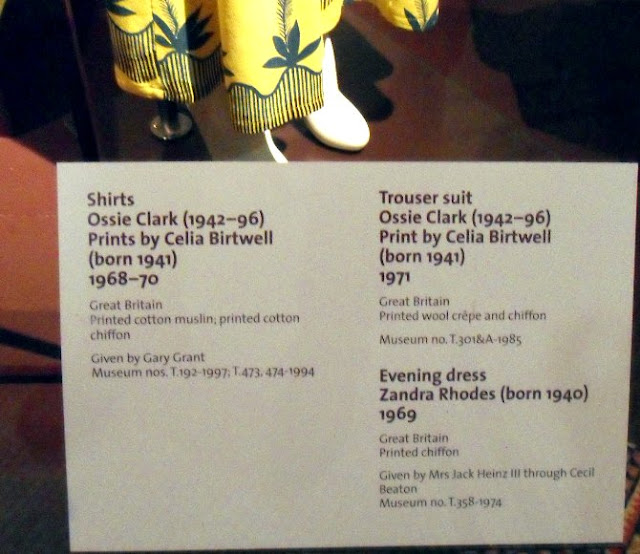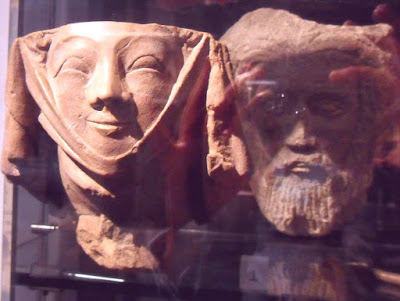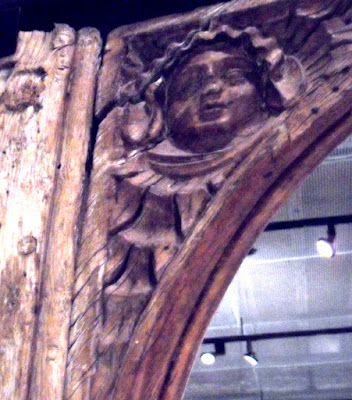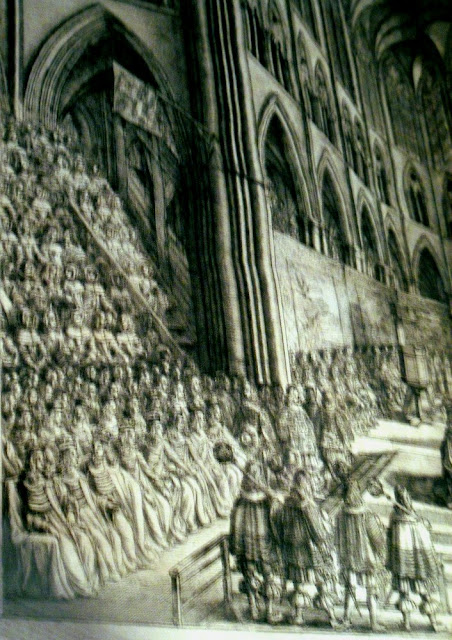Monday, June 20, 2016
19th and 20th Century Artist Interiors: Painted Documents
2D to 3D: Artist Room Studies by Jennifer Hawkins Hock are gimlet-eyed views of 19th and 20th century interiors painted by artists. 2D to 3D: Artist Room Studies presents assemblages of 15 paintings featuring as their subject artists' portraits of their own studios or domestic interiors. Group One includes three-dimensional assemblage studies of room portraits by Henri Matisse, Gwen John, Edouard Vuillard, Pierre Bonnard, Rene Magritte, Raoul Dufy, Gustave Caillebotte, Frederick Childe Hassam, Vincent van Gogh, and Vilhelm Hammershoi. Group Two of 2D to 3D: Artist Room Studies is currently in progress and highlights room portraits by Frederic Bazille, Odilon Redon, Vanessa Bell, and the artist's own studio. Additional rooms by artists featured in Group One will appear as well.
View of a View of a View
Quai Saint-Michel as 2D to 3D Artist Room Study of 1916 Atelier, Quai Saint-Michel by Henri Matisse, followed by a view of Quai Saint-Michel from the Seine:
 |
| Artist Room Study 5 Matisse - Jennifer Hawkins Hock, 2014/2015 |
 |
| Artist Room Study 5 Matisse - Jennifer Hawkins Hock, 2014/2015 |
 |
| Atelier, Quai Saint-Michel - Henri Matisse, 1916 |
 |
| Quai Saint-Michel viewed from the Seine, photo - Jennifer Hawkins Hock |
Saturday, June 18, 2016
2D to 3D: Artist Room Studies - A Preview
Exhibition premieres at the blog Art Fashion Creation 6.20.16. Read the Artist Room Studies exhibition notes at this AFC link. Here's a peek at one of the 15 Artist Room Studies:
 |
| Artist Room Study 3 Matisse - Jennifer Hawkins Hock, 2014/2016 |
Wednesday, June 15, 2016
Musee de la Toile de Jouy review
My favorite museum among the many visited during a 10-day trip from London, to Ghent, Bruges, then Paris and around Versailles - is the Musee de la Toile de Jouy. We traveled via bus (a trip of less than a half hour), found across from the train station - very near the Palace of Versailles entrance.
During the latter part of the 18th century there occurred a trend - people of affluence developed an affinity for rustic simplicity. The Queen's Hamlet of Versailles exhibits this preference for nature and for the charming structures of Norman or Flemish design. Likewise, many of the fabrics produced in Jouy-en-Josas at this time show a love of the countryside, depicting: orchards, ponds, mills, farm animals, meadows, birds, streams, cascades, flowers, and quaint figures in romantic poses, playing instruments, or tending to chores.
The toile de jouy cloth produced in Jouy-en-Josas by Oberkampf in the 18th century is a wonderful example of art reflecting its environment and of how art reflects popular culture. To be able to observe the actual landscape which influenced so many of the toile de jouy scenes, and to learn the methods in which the cloth was printed was a true honor. I hope to visit this beautiful setting again and spend more time in the museum.
Before visiting Musee de la Toile de Jouy, we did roam the Palace of Versailles to which we journeyed from Paris via Metro and then RER (train). Observing the crowds at the Palace of Versailles, it seems the majority of people prefer to head directly into the sumptuous areas, but we enjoyed a lengthy stroll from the Palace to the Queen's Hamlet, appreciating the design of the grounds. Earlier in the trip, I marveled at the Salle de Fetes (or grand ballroom) within the Musee d'Orsay - which I deemed comparable to what the Palace of Versailles might offer - extremely lovely and lavish:
But the Queen's Hamlet at the outer grounds of Versailles feels like a breath of fresh air in its sylvan simplicity. Scroll near the end of my earlier Paris Exploration post - here - to see photos from both Marie-Antoinette's Hamlet and the Musee de la Toile de Jouy.
We visited after our Versailles exploration and allotted only an hour within the museum, which happened to be the hour just before closing. I would like to spend at least two hours in the museum, studying the exhibits, the cloth - and spend additional time perusing the excellent gift shop. I was sorry to have to leave, but returning to Paris was simple enough - a short walk to the RER. More, here at the Musee de la Toile de Jouy website - or their document, in English.
During the latter part of the 18th century there occurred a trend - people of affluence developed an affinity for rustic simplicity. The Queen's Hamlet of Versailles exhibits this preference for nature and for the charming structures of Norman or Flemish design. Likewise, many of the fabrics produced in Jouy-en-Josas at this time show a love of the countryside, depicting: orchards, ponds, mills, farm animals, meadows, birds, streams, cascades, flowers, and quaint figures in romantic poses, playing instruments, or tending to chores.
The toile de jouy cloth produced in Jouy-en-Josas by Oberkampf in the 18th century is a wonderful example of art reflecting its environment and of how art reflects popular culture. To be able to observe the actual landscape which influenced so many of the toile de jouy scenes, and to learn the methods in which the cloth was printed was a true honor. I hope to visit this beautiful setting again and spend more time in the museum.
Before visiting Musee de la Toile de Jouy, we did roam the Palace of Versailles to which we journeyed from Paris via Metro and then RER (train). Observing the crowds at the Palace of Versailles, it seems the majority of people prefer to head directly into the sumptuous areas, but we enjoyed a lengthy stroll from the Palace to the Queen's Hamlet, appreciating the design of the grounds. Earlier in the trip, I marveled at the Salle de Fetes (or grand ballroom) within the Musee d'Orsay - which I deemed comparable to what the Palace of Versailles might offer - extremely lovely and lavish:
 |
| Salle de Fetes, Musee d'Orsay - Toile La La photo 2015 |
 |
| Salle de Fetes, Musee d'Orsay - Toile La La photo 2015 |
 |
| Salle de Fetes, Musee d'Orsay - Toile La La photo 2015 |
 |
| toile de jouy - image Musee de la Toile de Jouy |
 |
| image from Musee de la Toile de Jouy website |
Tuesday, June 14, 2016
Stellar Respiration: Star Breath-Sound
Via asteroseismology I've been listening to the stars breathe today and they sound ready to perform Darude's Sandstorm. Roaming and researching, I happened upon University of Birmingham studies of resonant oscillation - which reveal the noise or breath within a star, which reveal its age. Sound and brightness of a star vary with age. A star's oscillation affects its brightness and scientists are now able to digitally translate that oscillating breath. Hence, the Moog sound. Read more about stellar respiration here.
Monday, June 13, 2016
A.L.T.: A Memoir
To achieve an apex of style requires cultivation of perspective and a honing of the intellect - more than lavish expenditure. Simply, great luxury is to be found in a cultivated state of mind.
To merely listen or observe Andre Leon Talley, one senses cultivation - a cultivaton of tone, a regal bearing, a majestic presence which cannot be feigned - but which is a product of lifelong observation, education, and inherent self-awareness.
Reading A.L.T: A Memoir, we learn a determining factor in the A.L.T of today is his grandmother, who raised him in a strict, clean, healthy environment - free of artifice, but brimming with simple luxuries. Talley recalls this way of life with heartfelt appreciation - his narrative tone a blend of reverence and tangible, viable pleasure in the senses. His hard-working, church-going grandmother - Bennie Francis Davis - instilled in Talley, an only child, integrity, altruism, faith, and a loving respect for women.
Growing up, Talley witnessed the pride his grandmother obtained from her job, household chores, and a neat presentation of self (accented by the well-earned and deserved hat or perfect pair of gloves). We learn she always wore a hat to church and "her shoes always matched her handbag". Mrs. Davis provided Andre with what she knew to be the best environment a child can have - a safe, clean haven full of good food and good example. "In our family, cleanliness was so close to godliness that we plain had no congress with grime..., " says Talley, "Through soap and paste wax, rags, mops, and muscle power, I learned that cleaning itself can be restful, and that a well-kept home soothes the mind and spirit, making it easier to contemplate things beyond the physical and the everyday."
And in this well-kept home, Mrs. Davis allowed and encouraged Andre to dream his own dreams and to observe what made their lives special and wonderful... to appreciate the ways in which they were blessed. In Talley's description of a childhood electric storm - we sense the observing eyes which led to the fashion figure he is today:
There, in his childhod observations and in his beloved reading, is where Talley began to detect what constituted elegance. I love his discussion of the "luxury of high style" and his mention of cyclical creation: "No one has to reinvent the wheel- you just keep turning it around and around, recycling the ideas, the couture that was born in 18th century France spread all over Europe and even to Russia, and affected the art of conversation, the art of food, the art of flirting, the art of living, the art of serving up coffee in a beautiful cup."
Another post - at Art Fashion Creation - with love for ALT and gingham. The pink link will transport you swiftly. Another link here - 2012 SCAD fashion show.
To merely listen or observe Andre Leon Talley, one senses cultivation - a cultivaton of tone, a regal bearing, a majestic presence which cannot be feigned - but which is a product of lifelong observation, education, and inherent self-awareness.
Reading A.L.T: A Memoir, we learn a determining factor in the A.L.T of today is his grandmother, who raised him in a strict, clean, healthy environment - free of artifice, but brimming with simple luxuries. Talley recalls this way of life with heartfelt appreciation - his narrative tone a blend of reverence and tangible, viable pleasure in the senses. His hard-working, church-going grandmother - Bennie Francis Davis - instilled in Talley, an only child, integrity, altruism, faith, and a loving respect for women.
Growing up, Talley witnessed the pride his grandmother obtained from her job, household chores, and a neat presentation of self (accented by the well-earned and deserved hat or perfect pair of gloves). We learn she always wore a hat to church and "her shoes always matched her handbag". Mrs. Davis provided Andre with what she knew to be the best environment a child can have - a safe, clean haven full of good food and good example. "In our family, cleanliness was so close to godliness that we plain had no congress with grime..., " says Talley, "Through soap and paste wax, rags, mops, and muscle power, I learned that cleaning itself can be restful, and that a well-kept home soothes the mind and spirit, making it easier to contemplate things beyond the physical and the everyday."
And in this well-kept home, Mrs. Davis allowed and encouraged Andre to dream his own dreams and to observe what made their lives special and wonderful... to appreciate the ways in which they were blessed. In Talley's description of a childhood electric storm - we sense the observing eyes which led to the fashion figure he is today:
"Life after a storm began again with the smell of nature washed clean, a smell as invigorating and reviving as any I have experienced... . When the storm ended, drops of rain beaded against the window screens and left crystal pearls on the velvety leaves of the geraniums."Talley's ability to sit still and absorb is also evidenced in his appreciation for books - he says, "I loved everything about them - the musty, disintegrating smell of volumes that hadn't been opened in years and the heady aroma of a brand-new art book with glossy illustrations; the brightly colored graphics on paperback jackets and the faded red, orange, or green spines of library bindings; the sticky-smooth plastic on the books one could take home and the rough, goatskin feel of the revered books in the reference section."
There, in his childhod observations and in his beloved reading, is where Talley began to detect what constituted elegance. I love his discussion of the "luxury of high style" and his mention of cyclical creation: "No one has to reinvent the wheel- you just keep turning it around and around, recycling the ideas, the couture that was born in 18th century France spread all over Europe and even to Russia, and affected the art of conversation, the art of food, the art of flirting, the art of living, the art of serving up coffee in a beautiful cup."
Another post - at Art Fashion Creation - with love for ALT and gingham. The pink link will transport you swiftly. Another link here - 2012 SCAD fashion show.
Friday, June 10, 2016
London Exploration, Art Fashion History
Fashion, History, and Art my priorities - a sample of my Fall 2015 exploration... discovered in less than a week's time via metro, train, bus, and on foot. The London museums are incomparable - staffed with helpful and polite people. This was a wonderful, wonderful trip with every minute full of art and adventure. After visiting many of the London museums online and reading reviews, I selected the Victoria and Albert, the National Portrait Gallery London, the London Museum, and Tate Modern London - spending several hours in each.

All photos - Toile La La, 2015
 |
| Victoria and Albert, London 2015 - photo Toile La La |
 |
| London 2015 - photo Toile La La |
 |
| London 2015 - photo Toile La La |
 |
| London 2015 - photo Toile La La |
 |
| London 2015 - photo Toile La La |
 |
| London 2015 - photo Toile La La |
 |
| London 2015 - photo Toile La La |
 |
| London 2015 - photo Toile La La |
 |
| London 2015 - photo Toile La La |
 |
| London 2015 - photo Toile La La |
 |
| London 2015 - photo Toile La La |
 |
| small-scale shirt toile, Victoria and Albert, London 2015 - photo Toile La La |
 |
| London 2015 - photo Toile La La |
 |
| London 2015 - photo Toile La La |
 |
| London 2015 - photo Toile La La |
 |
| London 2015 - photo Toile La La |
 |
| London 2015 - photo Toile La La |
 |
| London 2015 - photo Toile La La |
 |
| London 2015 - photo Toile La La |
 |
| paper dresses, Victoria and Albert, London 2015 - photo Toile La La |
 |
| London 2015 - photo Toile La La |
 |
| London 2015 - photo Toile La La |
 |
| London 2015 - photo Toile La La |
 |
| deconstructed fashion, Victoria and Albert, London 2015 - photo Toile La La |
 |
| Victoria and Albert - fashion, London 2015 - photo Toile La La |
 |
| Victoria and Albert - fashion, London 2015 - photo Toile La La |
 |
| London 2015 - photo Toile La La |
 |
| Street Art, Trafalgar Square - London 2015 - photo Toile La La |
 |
| National Portrait Gallery, London 2015 - photo Toile La La |
 |
| detail, National Portrait Gallery London |
 |
| reviewing portrait miniatures, National Portrait Gallery London |
 |
| Museum of London 2015 - photo Toile La La |
 |
| London Wall near Museum of London |

 |
| 1760 dollhouse, Museum of London - photo Toile La La |
 |
| Queen Victoria's dolls, Museum of London - photo Toile La La 2015 |
 |
| Queen Victoria's dolls, Museum of London - photo Toile La La 2015 |
 |
| Queen Victoria's dolls, Museum of London - photo Toile La La 2015 |
 |
| Queen Victoria's dolls, Museum of London - photo Toile La La 2015 |
 |
| Museum of London, sixties film |
 |
| Museum of London, sixties film |
 |
| Rebecca Horn Pencil Mask, Tate Modern London - photo Toile La La 2015 |
 |
| Nicholas Hlobo, Lingcamango - Tate Modern London |
 |
| Seen, Tate Modern London 2015 - photo Toile La La |
 |
| Seen 2, Tate Modern London 2015 - photo Toile La La |
 |
| London 2015 - photo Toile La La |
 |
| London 2015 - photo Toile La La |
Subscribe to:
Comments (Atom)




























